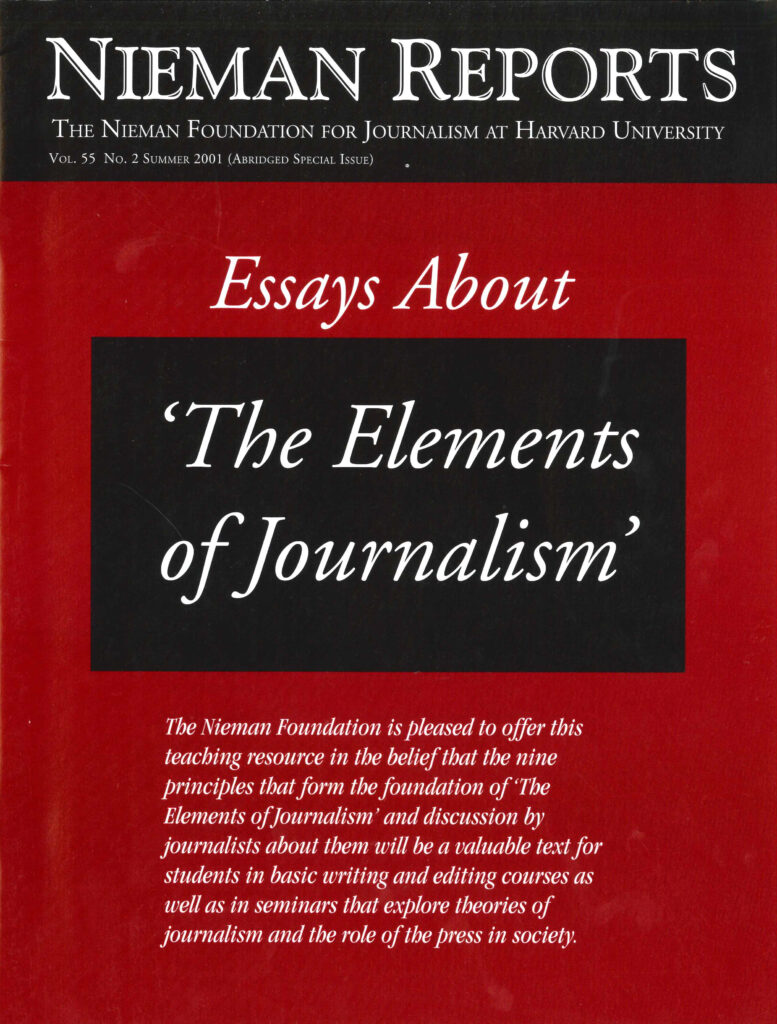“… This classic way of posing the question of engagement—as information versus storytelling, or what people need versus what people want—is a distortion. This is not how journalism is practiced, journalists told us. Nor is it, we believe, how people come to the news. The evidence suggests most people want both....
Storytelling and information are not contradictory. They are better understood as two points on a continuum of communicating.... Most journalism, like most communication, exists in the middle. The journalists’ task is to find the way to make the significant interesting for each story and finding the right mix of the serious and the less serious that offers an account of the day. Perhaps it is best understood this way: Journalism is storytelling with a purpose. That purpose is to provide people with information they need to understand the world. The first challenge is finding the information that people need to live their lives. The second is to make it meaningful, relevant, and engaging....
If journalism can be both significant and engaging, if people do not basically want it one way or the other, why does the news so often fall short? A litany of problems stand in the way of news being delivered compellingly: haste, ignorance, laziness, formula, bias, cultural blinders. Writing a story well, outside of the box of the inverted pyramid, takes time. It is, in the end, a strategic exercise that involves more than just plugging facts into short, declarative sentences. And time is a luxury of which journalists today feel they have less and less....
Even if reporters are given the time to report and write, there is the question of space in the paper or time on the newscast. With news organizations convinced that ever-shortening attention spans require ever-shorter stories, it is difficult for a reporter to get the space and time necessary to tell a story right....
The evidence suggests that attracting audiences by being merely engaging will fail as a business strategy for journalism over the long term for three simple reasons. The first problem is that if you feed people only trivia and entertainment, you will wither the appetite and expectations of some people for anything else.... The second long-term problem with the strategy of infotainment is that it destroys the news organization’s authority to deliver more serious news and drives away those audiences who want it....
Finally, the infotainment strategy is faulty as a business plan because when you turn your news into entertainment, you are playing to the strengths of other media rather than your own. How can the news ever compete with entertainment on entertainment’s terms? Why would it want to? The value and allure of news is different. It is based on relevance. The strategy of infotainment, though it may attract an audience in the short run and may be cheap to produce, will build a shallow audience because it is built on form, not substance. Such an audience will switch to the next “most exciting” thing because it was built on the spongy ground of excitement in the first place....”
Storytelling and information are not contradictory. They are better understood as two points on a continuum of communicating.... Most journalism, like most communication, exists in the middle. The journalists’ task is to find the way to make the significant interesting for each story and finding the right mix of the serious and the less serious that offers an account of the day. Perhaps it is best understood this way: Journalism is storytelling with a purpose. That purpose is to provide people with information they need to understand the world. The first challenge is finding the information that people need to live their lives. The second is to make it meaningful, relevant, and engaging....
If journalism can be both significant and engaging, if people do not basically want it one way or the other, why does the news so often fall short? A litany of problems stand in the way of news being delivered compellingly: haste, ignorance, laziness, formula, bias, cultural blinders. Writing a story well, outside of the box of the inverted pyramid, takes time. It is, in the end, a strategic exercise that involves more than just plugging facts into short, declarative sentences. And time is a luxury of which journalists today feel they have less and less....
Even if reporters are given the time to report and write, there is the question of space in the paper or time on the newscast. With news organizations convinced that ever-shortening attention spans require ever-shorter stories, it is difficult for a reporter to get the space and time necessary to tell a story right....
The evidence suggests that attracting audiences by being merely engaging will fail as a business strategy for journalism over the long term for three simple reasons. The first problem is that if you feed people only trivia and entertainment, you will wither the appetite and expectations of some people for anything else.... The second long-term problem with the strategy of infotainment is that it destroys the news organization’s authority to deliver more serious news and drives away those audiences who want it....
Finally, the infotainment strategy is faulty as a business plan because when you turn your news into entertainment, you are playing to the strengths of other media rather than your own. How can the news ever compete with entertainment on entertainment’s terms? Why would it want to? The value and allure of news is different. It is based on relevance. The strategy of infotainment, though it may attract an audience in the short run and may be cheap to produce, will build a shallow audience because it is built on form, not substance. Such an audience will switch to the next “most exciting” thing because it was built on the spongy ground of excitement in the first place....”



